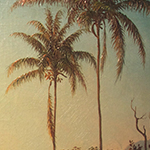
Fritz Melbye was the youngest of the three artist brothers and was born in Helsingør on Øresund in 1826.
Anton Melbye introduced him to painting and drawing techniques. Already in Copenhagen, Fritz Melbye became acquainted with plein air painting in bright sunlight and became an attentive observer of nature on his home coast on the Baltic Sea.
He made his debut in the 1849 exhibition of the Copenhagen Academy of Fine Arts with two seascapes, before leaving for the Caribbean for the then Danish West Indian Islands of St. Thomas, St. Croix and St. John, today's American Virgin Islands. He did not return to live in Denmark again. In 1858, the Danish king bought a painting from Fritz Melbye of the port of Charlotte Amalie on St. Thomas.

The tropical light and the lush vegetation of the Caribbean and South America stimulated Fritz Melbye to produce intensive studies of nature and of clouds. Fresh oil sketches painted outdoors with a sweeping brushstroke, spontaneous pencil and pen-and-ink drawings document Melbye's explorations of the coasts and the jungle.
His paintings circulated in Copenhagen as colour lithographs. Around 1850, Fritz Melbye met Camille Pissarro on St. Thomas and had a significant impact on the artistic beginnings of the young man, who was later to become the father of French impressionism. In the years between 1852 and 1854, the two friends trained each other on Venezuela’s pristine nature and maintained a studio in Caracas, before Fritz Melbye met his brother Anton and Pissarro again in Paris in 1856/57.

From 1858 onwards, Fritz Melbye settled down in New York. In North America, also nature was to remain the focus of his artistic interests. From New York he travelled along the Mississippi, to the Great Lakes, into the Canadian forests and to the Arctic Ocean. Fritz Melbye regularly exhibited his work in Philadelphia and New York. Amongst American collectors he was held in high esteem as a painter of the South American tropics and of pristine landscapes.
In 1865, Fritz Melbye travelled to Jamaica with Frederic Edwin Church, himself a South America-traveller and member of the landscape painters of the Hudson River School. Melbye spent over a year sketching and painting on the Caribbean island.

In 1867, Fritz Melbye started a round-the-world tour. He left his property, including a large collection of oil studies and drawings, in the safekeeping of Frederic Edwin Church in New York. In Japan and China, he created paintings, fresh oil sketches en plein air and drawings of the coastlines and the countryside.
In 1868/69, Melbye witnessed the Boshin war in Japan and supplied drawings of events to the North American illustrated press. In December 1869, at the age of 43, he died of a fever in Shanghai.
wrote Fritz Melbye from Venezuela to Camille Pissarro in Paris in 1856. The study of wild nature, untouched by the impact of civilization, became Melbye's artistic credo. It drove the Dane to "unclassical", exotic and extreme scenic sites in the world, far away from Europe’s art centres.
Without having received any academic training and influenced by the idea of the aesthetic value of a simple, everyday environment, and by plein air oil studies he had seen in Copenhagen, Melbye approached nature intuitively in extraordinarily lively oil sketches painted en plein air with a quick, broad brush or captured his impressions in spontaneous, dynamic pencil or pen-and-ink drawings. In their immediacy, subtlety, and naturalness, these works stand in contrast to Melbye's finely painted, colour-intensive paintings, which reflect a sentimental perception of nature, or even display idealized compositions with a naïve touch.
Fritz Melbye´s influence on Pissarro’s development as an artist, who had a significant impact on the French avant-garde, and the often difficult distinction of their early works, are current research topics.
Picture excerpts Life stations
1) Fritz Melbye, Segler im Morgenlicht, 1848 (private collection)
2) und 3) Fritz Melbye, La Guayara, Venezuela, 1853 (private collection)
4) Fritz Melbye, Waldlichtung in Japan, o.Dt. (private collection)
Detail
Camille Pissarro, Im Atelier von Fritz Melbye und Camille Pissarro in Caracas, Venezuela, 1854 (Col. Banco Central de Venezuela, Caracas)